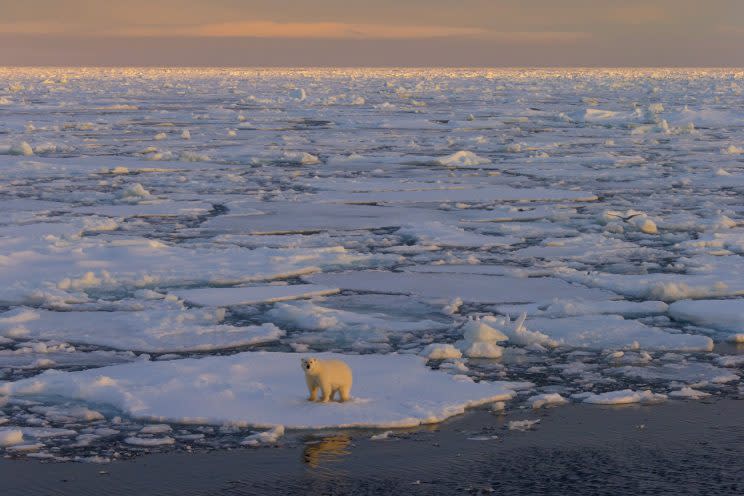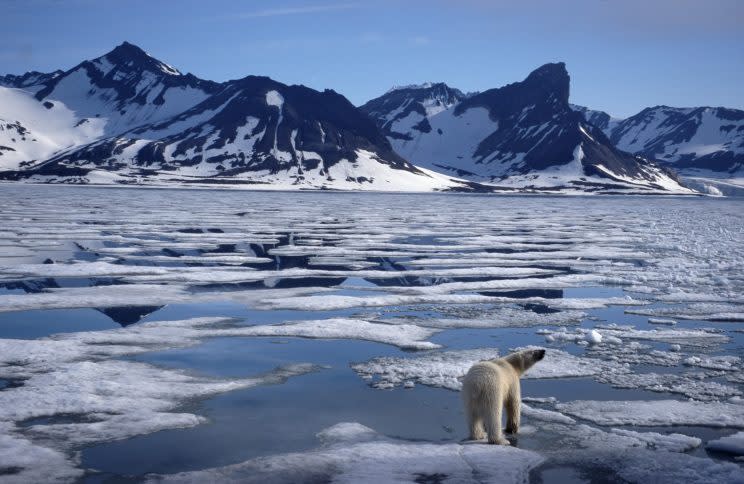Bizarre North Pole temperatures cap off year of record-setting warmth
Christmastime conjures up beautiful images of the frozen North Pole, but if warming trends continue unabated, Santa’s home will look very different in years to come.
The Global Forecast System, a weather prediction system run by the U.S. National Weather Service, forecasts that the temperature at the North Pole could inch close to the melting point of 32 degrees Fahrenheit on Thursday — nearly 50 degrees warmer than normal.
It’s a fitting end to 2016, which is expected to be the third year in a row to set new highs for hottest year on record.
Zack Labe, a doctoral student who focuses on the global climate system at the University of California, Irvine, said Wednesday that a series of storm systems — which are moving up through the North Atlantic Ocean and off the east coast of Greenland — are drawing warm and moist air into the Arctic — especially near the North Pole.
“In response, temperatures will briefly rise to values nearly 30 to 45 degrees Fahrenheit or more above normal (mainly on Thursday). Some weather models show temperatures hovering just below the freezing point,” Labe told Yahoo News.

“Record ‘warmth’ has been mostly persistent in the Arctic during the fall and helped to contribute to record low extent and volume of sea ice. While temperatures are variable in the Arctic, the persistence of such ‘warmth’ this year is very unusual.”
Temperatures vary considerably throughout the Arctic, but there is an overall trend of gradual warming and decreasing sea ice, which has consequences for the overall climate system.
Labe added that the causes of these unusually high temperatures are likely to include the result of current weather patterns, natural climate variability and climate change.
“Temperatures will begin to fall by the end of the week at the North Pole, but still remain above normal,” he said.
The National Aeronautics and Space Administration (NASA) reports that the 10 hottest years on record in the past 136 years have all occurred since 2000, with the exception of 1998. This finding is largely consistent with similar research from the National Oceanic and Atmospheric Administration (NOAA) and the Climatic Research Unit at the University of East Anglia in England.

Gavin Schmidt, a climatologist and the director of the NASA Goddard Institute for Space Studies in New York, said 2017 is not expected to be the warmest year on record (for a fourth consecutive year), but that the big-picture trend is predicted to continue.
“We have this situation where we do have these long-term trends — they’re not going away,” he told Yahoo News. “The trend is the main thing that we are trying to understand. What’s important for being able to predict the future is the long-term trends. It’s not the details of what happens in one year or another.”
According to the overwhelming scientific consensus, human activities have largely been responsible for the unprecedented changes in the global climate since the Industrial Revolution. The amount of heat-trapping carbon dioxide that has been emitted into the atmosphere as a result of human activities like fossil fuel use and deforestation has accelerated global warming.
In a statement, the American Association for the Advancement of Science said, “The scientific evidence is clear: Global climate change caused by human activities is occurring now, and it is a growing threat to society.”
As far as NASA can estimate now, Schmidt said, 2016 is expected to go down as “very clearly” the warmest year on record. This official designation will depend on the numbers for the final days of December.
He said NASA and NOAA plan to hold a joint press conference on Jan. 18 to reveal data for the entire year after it’s processed.
“The year to date, not including [this] December, was quite clearly the warmest on record. You can see that in our data sets very easily,” he said. “It seems inevitable that 2016 will be the warmest year on record.”



